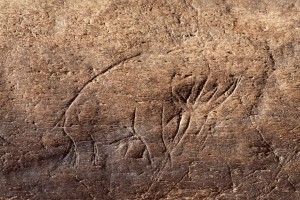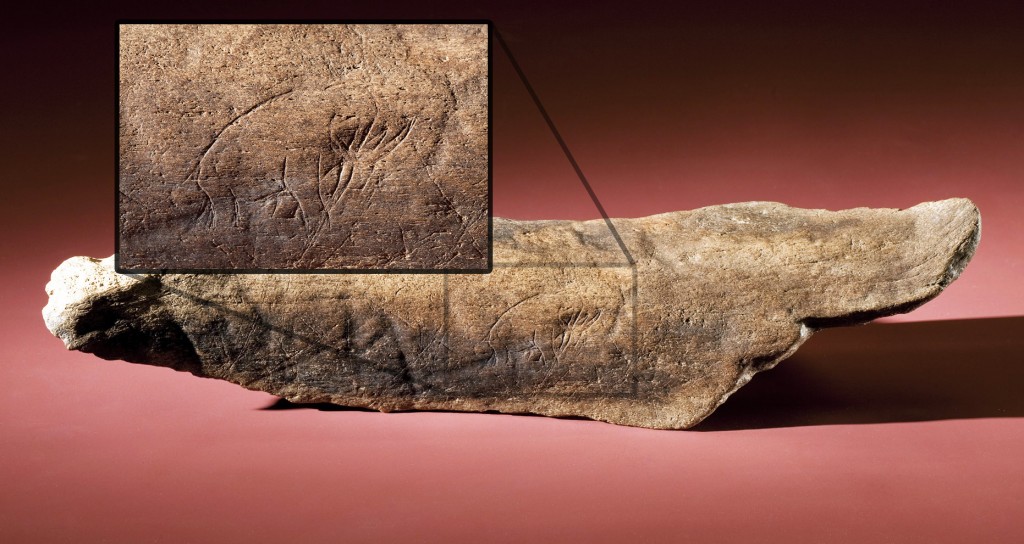 Researchers from the Smithsonian’s National Museum of Natural History and the University of Florida have confirmed in a new study published in the Journal of Archaeological Science that an engraved fossilized bone fragment discovered by an amateur fossil hunter in Vero Beach, Florida four or five years ago is at least 13,000 years old and is thus the first, and so far only, Ice Age image depicting a trunked animal ever found in the United States.
Researchers from the Smithsonian’s National Museum of Natural History and the University of Florida have confirmed in a new study published in the Journal of Archaeological Science that an engraved fossilized bone fragment discovered by an amateur fossil hunter in Vero Beach, Florida four or five years ago is at least 13,000 years old and is thus the first, and so far only, Ice Age image depicting a trunked animal ever found in the United States.
The engraving is of a mastodon or a mammoth and was done on a bone that once belonged to a mammoth, mastodon or giant sloth. There are all kinds of ancient depictions of mastodons and mammoths on cave walls and engraved on bones in Europe, but even though we know from the fossil record that proboscideans (trunked animals) existed in the Americas, this is the first human representation of one found.
Fossil aficionado James Kennedy discovered the bone in 2006 or 2007 (he can’t quite recall) and put it in a cabinet under his sink where it remained until 2009 when he fished it out and dusted it off. It was only after cleaning it that he saw the engraving and contacted scientists at the University of Florida, the Smithsonian’s Museum Conservation Institute and National Museum of Natural History who took custody of the object and began to study. Kennedy told National Geographic in 2009:
“I had no idea it was this big of a fuss. [When I heard] there was nothing else like it in the Western Hemisphere, that’s when my heart kind of stopped.”
Initial analysis performed by the researchers consistently pointed to both fossil and engraving being genuine and ancient, but it has taken a full two years for the team to complete the study and publish the final results. Their initial departure point was skepticism because nothing of its kind had been found before, and even if the fossil was genuine, the engraving could well have been a modern hoax modeled after similar ones in Europe.
Kennedy found the bone near the Old Vero site, the spot where geologist Elias Howard Sellards found human bones lying side-by-side with the bones of extinct Ice Age animals in an excavation between 1913 and 1916. He concluded that humans had hunted animals at Vero Beach during the last Ice Age, but his claims have been disputed ever since.
The team compared the elemental composition of the engraved bone to other comparable fossils discovered at the Old Vero site. Rare earth element analysis indicated the fossil was ancient and originated at or around the Old Vero site. Since mammoths, mastodons and giant sloths died out in the area about 13,000 years ago, the bone must be older than that. Forensic examination of the engraving indicated that it was not recent, but rather aged and mineralized along with the bone.
Optical microscopy results show no discontinuity in coloration between the carved grooves and the surrounding material indicating that both surfaces aged simultaneously. Scanning electron microscopy (SEM) revealed that the edges of the inscription are worn and show no signs of being incised recently or that the grooves were made with metal tools. In addition, the backscattered SEM images suggest there is no discontinuity in the distribution of light and heavy elements between the scribed region and the surrounding bone indicating that both surfaces aged in the same environment. This is very different from an intentional mark made on the bone for comparison. Energy dispersive x-ray spectroscopy (EDXS) shows that the surface contains significant amounts of calcium, phosphorus, oxygen, and carbon typical of a mineralized bone surface. Examination of a cast and mold of the incised bone by Reflectance Transformation Imaging (RTI) also provided no evidence that the engraving was made recently.
The data are thus conclusive enough for the researchers to announce that this is indeed the first mastodon/mammoth representation ever found in the Americas.
The bone is still squirreled away in the lab for now, but you can see a cast of it at the Florida Museum of Natural History in Gainesville. Its future is in question. In 2009, Kennedy said he was undecided about whether to sell it or donate it to the Florida Museum of Natural History. Here’s hoping he’s made up his mind to do the right thing and give it (or sell it, for that matter) to a museum.
